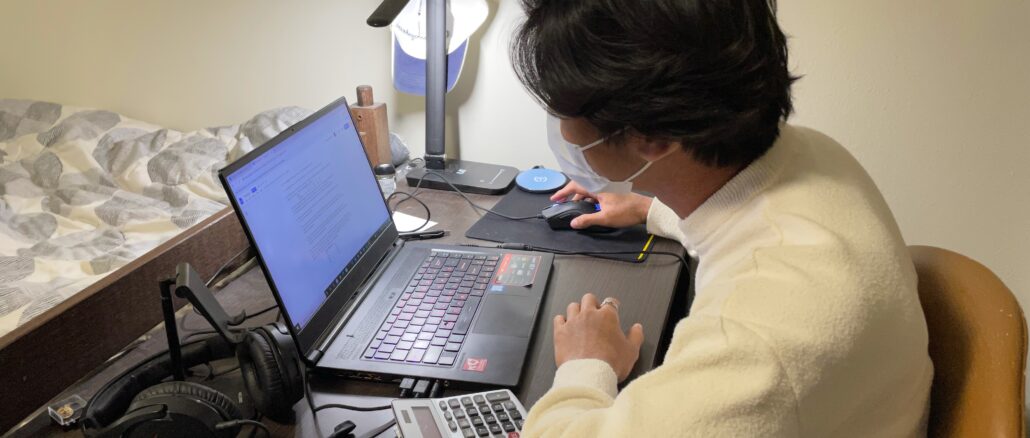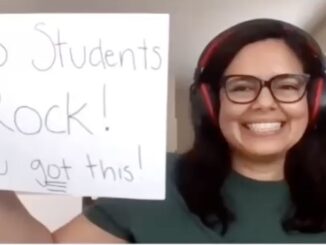
Joshua Lim, a junior business administration major from Torrance, California, came down with COVID-19 Jan. 6. This forced Lim to isolate at home just as Pepperdine’s spring academic semester began. He was in isolation for about a month, attending classes remotely.
“I was pretty much asymptomatic for my COVID-19 experience,” Lim said. “The fact that I had COVID-19 and the fact that it wasn’t going away, longer than two weeks extending on to the fourth week, and I kept testing positive, that’s where it really dropped my mental [health].”
The frustration Lim felt has been a challenge for many other students who quarantined. There have been 1,024 student cases, with 955 cases on-campus, according to Pepperdine University’s COVID-19 dashboard. Isolation made it difficult for students to learn remotely while their peers were in person.
Isolation rules forced a hyflex learning environment
Up until March 21, students at Pepperdine University had to get a weekly PCR COVID-19 test to ensure the safety of everyone on campus. When anyone tests positive for COVID-19, they need to go into an isolation period that ranged depending on their symptoms and whether they continued to test positive for the virus, according to the Student Health Center.
The university had to place students in five different hotels to isolate everyone after 656 contracted COVID-19 in the first two weeks of classes, Abby Wilt and Kyle McCabe wrote Jan. 19, 2022, in a Pepperdine Graphic article.
Isolation for students caused problems for everyone. Professors had to accommodate students, and many utilized new cameras in the classroom to offer what educational scholars call a hyflex learning environment. Hyflex learning allows for a hybrid, flexible online and in-person approach, according to the National Education Association.
The hyflex environment put students and professors in an unusual situation,where some students were learning online and some were learning in-person. When most students were in person, the students attending class remotely struggled.
“For students, particularly, I think they’re experiencing a lot of isolation, especially when we were 100% online, this isn’t what they signed up for,” said Carrie Wall, the undergraduate coordinator for the Teacher Preparation Program and an education professor. “Developmentally, I think that was very difficult for particular high school and college students who need to be in community with peers.”
Chelsey Yang, a junior business administration major from Los Angeles, is one student who felt this struggle when she was isolated and on Zoom the first few weeks of classes.
“I think students tend to understand better when they are in person since they can ask questions compared to not wanting to speak up on Zoom,” Yang said.
Wall said students who were struggling online and during isolation made it stressful and emotional for professors who were trying to accommodate their online students’ needs while setting up their classroom for those coming to learn in-person.
“Cognitive load is very heavy,” Wall said. “Additionally, I would say the emotional load has been much heavier.”
Andrea Harris, senior director of Academic Advising Center, said needing to use the hyflex environment didn’t cause anymore student withdrawal or probation numbers compared to other years.
“We didn’t have worse problems or more problems at all,” Harris said.
Pepperdine was online for the first three days of the spring semester and then classes went to the hyflex learning environment. Harris said there were a large number of students who withdrew in advance of the semester since they didn’t want to be involved in the hyflex environment.
Student experience with contracting COVID-19
While Lim was not alone in contracting COVID-19 at the beginning of the semester, he was unique in having to be in isolation for about a month.
“It was pretty lonely, since I had to quarantine in my room and couldn’t talk to family or friends much,” Lim said. “It was a lonely experience, and personally for me I love being with my friends and talking with other people so it was a rough situation.”
Lim only experienced a stuffy nose and fever once or twice. But Lim said the isolation decreased his mental health.
Students’ stress can heavily impact physical, mental and emotional health, according to a Balneo and PRM Research Journal study that showed the differences between students who got COVID-19 during their first, second and third year of the pandemic.
Students who contracted COVID-19 at some point in their academic life expressed fear, anxiety, behavioral disorders or limited physical activities during their isolation periods, according to the study. The authors wrote this was a public health issue for these students, which restricted them from fully excelling in their learning.
“It was pretty lonely,” Lim said. “I had to quarantine in my room and couldn’t talk to family or friends much and had to wear a mask around the house and keep my distance from family.”
Lim said he feared giving his family or friends COVID-19 if he wasn’t careful in his isolation, which added more mental stress.
Learning difficulties during isolation
Yang experienced increased feelings of anxiety and fear during her time in isolation, mostly because she worried about her performance in class.
“One thing I would be really scared of is tech issues,” Yang said. “Like especially taking a test, the WiFi would crash and would some professors understand and some who are not you know.”
Justin Kim, a junior sports medicine major from Los Angeles, was also out with COVID during the first weeks of spring classes.
“Just being on an online format makes things a little bit more difficult to keep up with things since I’m not there directly being involved with learning,” Kim said. “Just with watching Zoom recordings Zoom lectures, you’re not really learning anything myself.”
Student collaboration is much better in person than online since there is the ability to interact with the professors in person and get instant feedback, Kim said.
“I kind of felt like my education was kind of on the backburner, but you know contrast that to now I’m on campus, now I get to engage with my professors,” Kim said. “I noticed that just being in the classroom and having the professor talking is so much more engaging.”
Returning to in-person learning from isolation
The transition period from isolation back to in-person learning is very challenging but many students said they were able to bounce back and learn more efficiently upon their return to the classroom. All said they were able to catch up in their classes.
Lim was one student who said he was relieved when he got to go back to in-person classes.
“I prefer in person, I don’t really like online because it’s hard to connect with the teacher and other students in my like and just with friends in general,” Lim said.
Being in person made him focus more on his schoolwork, Lim said.
“I get distracted pretty easily and if the teacher’s right there, I can’t go on my phone or watch videos or play games while the teacher is lecturing online, which I could do back at home doing online learning,” Lim said.
Kim thought that returning to in-person learning was helpful for him because of the learning setbacks he faced in isolation.
“From my own personal experience, it made things better to be back,” Kim said. “I was more productive cause I was really in the moment and it felt like such a priority, education and learning, compared to being at home.”
Lim said he did have to readjust to the commute.
“Being in person makes it a little harder because I have to go to different classrooms,” Lim said. “Instead of being in one location with a laptop, where I can instantaneously go into another classroom, I move around and have stuff to do on campus.”
Yang said she had some anxiety readjusting to the classroom after attending remotely in isolation.
“Just trying to stay engaged is tough since you don’t get to use your distractions like your phone or eating food when you are in-person,” Yang said. “So it’s stressful trying to stay engaged when I’m so used to doing what I want when I’m learning online.”
Wall described the mental load students are carrying after coming back from the isolation period.
“The amount of time, this semester particularly, that I have spent with them emailing me ‘I don’t think I can come to class today, I’m feeling a lot of anxiety,’” Wall said.
Harrris addressed a student experience she had where the mental weight of in-person learning seemed to get to them.
“We have students, I even got a report this morning of a student who stopped attending classes before spring break and hasn’t come back since,” Harris said. “And I know the person’s here, I just don’t know why they’re not going to class. But it’s a different field since in their mind I can just ask for recorded lectures and I’ll catch up.”
Returning to social life
Lim also struggled during isolation because he was missing important club events.
Lim is a part of many on campus clubs like Koinonia Campus Mission, the Korean Student Association and business fraternity Delta Sigma Pi.
“Many of the other members in DSP specifically were getting frustrated that I was continuously not showing up to events,” Lim said. “It felt like they wanted me to show up even with COVID-19.”
Coming back from isolation, Lim had to make up a lot of his club work and had to help out during events overtime since he wasn’t available for the past events. These club events did add stress to Lim but he was able to overcome it and maintain his academic life.
“At least for me, this semester’s homework hasn’t been too bad,” Lim said.
Matthew Park reported this enterprise story in Jour 241 during the Spring 2022 semester under the supervision of Dr. Christina Littlefield and Dr. Theresa de los Santos. Dr. Littlefield supervised the web article.




